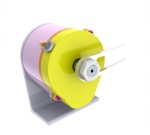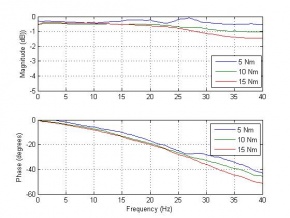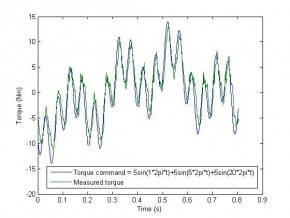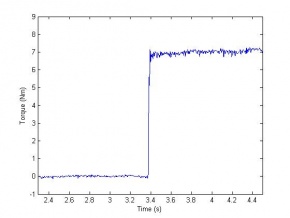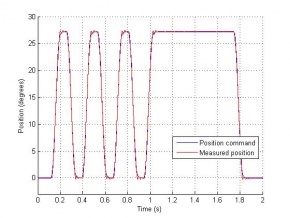Difference between revisions of "DDRA"
(→Publications) |
|||
| (91 intermediate revisions by 7 users not shown) | |||
| Line 1: | Line 1: | ||
| + | <analytics uacct="UA-27707792-1" ></analytics> | ||
| + | |||
<big><french>ADDR - Actionneur à double différentiel rhéologique (en instance de brevet) </french><english>DDRA - Double Differential Rheological Actuator (patent pending)</english></big> | <big><french>ADDR - Actionneur à double différentiel rhéologique (en instance de brevet) </french><english>DDRA - Double Differential Rheological Actuator (patent pending)</english></big> | ||
| − | + | = Description = | |
| − | + | <english>Robotic systems are increasingly moving out of factories, stepping into a dynamic world full of unknowns, where they must interact in a safe and versatile manner. Traditional actuation schemes, which rely on position control and stiff actuators, often fail in this new context. There have been many attempts to modify them by adding a full suite of force and position sensors and by using new control algorithms but, in most cases, the naturally high output inertia and the internal transmission nonlinearities such as friction and backlash remain quite burdensome. | |
| − | + | ||
| − | |||
| − | |||
| − | |||
| − | |||
| + | The proposed actuation scheme addresses many of those limitations. The DDRA uses a differentials mechanism and two magnetorheological brakes coupled to, for example, an electromagnetic motor. This configuration enables the DDRA to act as a high bandwidth, very low inertia, very low friction and without backlash torque source that can be controlled to track any desired interaction dynamics. The advantages include safety and robustness due to extreme backdrivability and a lot of versatility in interactions. In a more traditional context, the actuator’s low inertia, eliminated backlash and reduced nonlinearities allow for greater accelerations and a more precise positioning, thus improving productivity and quality.</english> | ||
| − | + | <french>Les systèmes robotiques sont appelés à sortir des environnements contrôlés et à faire face à un monde dynamique et plein d'inconnus où ils doivent interagir de façon sécuritaire et polyvalente. Les technologies d'actionneur classiques, rigides et contrôlées en position, faillissent souvent à la tâche dans ce nouveau contexte. Malgré une gamme de capteurs élargie et des algorithmes de contrôle avancés, l'inertie naturelle ainsi que les non-linéarités de la transmission, comme la friction et le jeu, demeurent néfastes. | |
| − | < | ||
| − | + | Le concept d'actionneur proposé élimine plusieurs de ces limitations. L'ADDR utilise un mécanisme différentiel et deux freins magnétorhéologiques couplés, par exemple, à un moteur électromagnétique. Cette configuration permet à l'ADDR d'agir comme une source de couple à haute bande passante, de très faible inertie, de très faible friction et avec un jeu nul qui peut être asservie pour reproduire une dynamique d'interaction choisie. Les avantages incluent une sécurité et une robustesse accrues ainsi qu'une très grande polyvalence dans les interactions. Également, dans un contexte plus traditionnel d'automatisation et de robotique industrielle, l'ADDR permet de fortes accélérations et un positionnement très précis permettant un gain de productivité et de qualité des opérations.</french> | |
| + | <center> | ||
| + | [[Image:DDRA evolution.jpg|880px|center|DDRA from proof-of-concept (Prototype 0) to first compact integration (Prototype 1)]] | ||
| + | </center> | ||
| − | |||
| − | + | <english>= Videos =</english><french>= Vidéos =</french> | |
| + | <center> | ||
| + | <code>{{#ev:dailymotion|xbxi91}}</code> | ||
| + | </center> | ||
| + | <english> Download [http://www.apple.com/quicktime/download/ QuickTime] for these videos.</english><french> Téléchargez [http://www.apple.com/quicktime/download/ QuickTime] pour visionner ces vidéos.</french> | ||
| + | <french> | ||
| + | * [[Media:DDRA_March2010.mov | DDRA as a High Performance Haptic Interface (Février 2010)]] | ||
| + | * Contrôle d'interaction (Décembre 2009): [[Media:Ressort.mp4 | Simulation d'un ressort]] / [[Media:Mur.mp4 | Simulation d'un mur]] | ||
| + | * [[Media:DDRA_proto_1_-_English_HD.mp4 | Prototype 1 (Juin 2009)]] | ||
| + | * [[Media:DR2_Prototype1.mp4 | Preuve de concept Prototype 0 (Décembre 2008)]] | ||
| + | </french> | ||
| + | <english> | ||
| + | * [[Media:DDRA_March2010.mov | DDRA as a High Performance Haptic Interface (February 2010)]] | ||
| + | * Interaction control (Decembre 2009): [[Media:Ressort.mp4 | Simulation of a spring]] / [[Media:Mur.mp4 | Simulation of a wall]] | ||
| + | * [[Media:DDRA_proto_1_-_English_HD.mp4| Prototype 1 (June 2009)]] | ||
| + | * [[Media:DR2_Prototype1.mp4 | Proof-of-concept Prototype 0 (December 2008)]] | ||
| + | </english> | ||
| + | <english>= Status =</english><french>=État d'avancement=</french> | ||
| + | {| class="wikitable" valign="top" style="text-align:left; width:100%; border:0px solid;" | ||
| + | |- | ||
| + | | | ||
| + | ! scope=col | Prototype 1 | ||
| + | ! scope=col | Prototype 1b | ||
| + | ! scope=col | <english>Prototype 2 (under construction)</english><french>Prototype 2 (en construction)</french> | ||
| + | |- | ||
| + | ! scope=row | | ||
| + | |[[Image:DR2 prototype compact 1.jpg | 150px | left|DDRA]] | ||
| + | |[[Image:DR2 prototype compact 1b.jpg | 150px | left|DDRA]] | ||
| + | |[[Image:DR2 prototype compact 2.jpg | 150px | left|DDRA]] | ||
| + | |-valign="top" | ||
| + | ! scope=row |<english>Nominal power</english><french>Puissance nominale</french> | ||
| + | |90 W | ||
| + | |96 W | ||
| + | | - | ||
| + | |-valign="top" | ||
| + | ! scope=row | <english>Nominal torque</english><french>Couple nominal</french> | ||
| + | |11 Nm | ||
| + | |12 Nm | ||
| + | | - | ||
| + | |-valign="top" | ||
| + | ! scope=row | <english>Maximum torque</english><french>Couple maximal</french> | ||
| + | |20 Nm | ||
| + | |12 Nm | ||
| + | | - | ||
| + | |-valign="top" | ||
| + | ! scope=row | <english>Inertia</english><french>Inertie</french> | ||
| + | |1.2e-4 kg.m² | ||
| + | | - | ||
| + | | - | ||
| + | |-valign="top" | ||
| + | ! scope=row | <english>Power Rate</english><french>Power Rate</french> | ||
| + | |1025 kW/s | ||
| + | | - | ||
| + | | - | ||
| + | |-valign="top" | ||
| + | ! scope=row | <english>Torque bandwidth</english><french>Bande passante de couple</french> | ||
| + | |<english>>40 Hz (limit of test)</english><french>>40 Hz (limite du test)</french> | ||
| + | |33 Hz | ||
| + | | - | ||
| + | |-valign="top" | ||
| + | ! scope=row | <english>Maximum speed</english><french>Vitesse maximale</french> | ||
| + | |160 RPM | ||
| + | |68 RPM | ||
| + | | - | ||
| + | |-valign="top" | ||
| + | ! scope=row |<english>Reduction ratio</english><french>Ratio de réduction</french> | ||
| + | |33:1 | ||
| + | |123.79:1 | ||
| + | | - | ||
| + | |-valign="top" | ||
| + | ! scope=row |<english>Dimensions ratio</english><french>Dimensions</french> | ||
| + | |90 dia X 137 mm | ||
| + | |83 dia X 145 mm | ||
| + | | - | ||
| + | |-valign="top" | ||
| + | ! scope=row |<english>Weight</english><french>Masse</french> | ||
| + | | 2.4 kg | ||
| + | |1.65 kg | ||
| + | | - | ||
| + | |} | ||
| − | |||
| + | <english>'''Force control:'''</english><french>'''Contrôle en force:'''</french> | ||
| + | <center> | ||
| + | {|style="width:100%;" height:400px; salign=center; | ||
| + | |[[File:Bode_plot_0-40_Hz_DDRA.jpg|290px|center|Torque control bode plot]] | ||
| + | |[[File:Consigne_couple_compose.jpg|290px|center|Torque command following]] | ||
| + | |[[File:Step_7Nm.jpg|290px|center|Torque step]] | ||
| + | |} | ||
| + | </center> | ||
| − | |||
| − | + | <english>'''Position control:'''</english><french>'''Contrôle en position:'''</french> | |
| + | [[Image:Position_following_27deg_8Nm_PIDc.jpg|290px|Position command following (0.084 kg.m.m load, 8 Nm nominal, PIDc)]] | ||
| − | |||
| + | <span id="ancre_interaction"></span> | ||
| + | <english>'''Interaction control:'''</english><french>'''Contrôle d'interaction:'''</french> | ||
<center> | <center> | ||
| − | + | {| class="wikitable" style="text-align:center; width:100%;" | |
| + | |- | ||
| + | |<english>Simulation of a spring</english><french>Simulation d'un ressort</french> | ||
| + | |<english>Simulation of a wall</english><french>Simulation d'un mur</french> | ||
| + | |- | ||
| + | |<code>{{#ev:dailymotion|xbs3jv}}</code> | ||
| + | |<code>{{#ev:dailymotion|xbs3i7}}</code> | ||
| + | |} | ||
| + | |||
</center> | </center> | ||
| + | <english>= Patents =</english><french>= Brevets =</french> | ||
| + | * http://www.google.com/patents/US20110045932 | ||
| − | + | = Publications = | |
| − | |||
| − | |||
| + | #Fauteux, P., Lauria, M., Heintz, B., Michaud, F. (2010), “Dual differential rheological actuator for high performance physical robotic interaction,” IEEE Transactions on Robotics, 26(4):607-618. [[Media:TRO2010.pdf|(pdf)]] | ||
| + | #Heintz, B., Fauteux, P., Létourneau, D., Michaud, F., Lauria, M. (2010), “Using a dual differential rheological actuator as a high-performance haptic interface,” IEEE/RSJ International Conference on Intelligent Robots and Systems. [[Media:IROS2010_BH.pdf|(pdf)]] | ||
| + | #Fauteux, P. (2010), Conception d'un actionneur adapté à l'interaction physique dans un contexte de robotique, Mémoire de maîtrise, Département de génie mécanique, Université de Sherbrooke. [[Media:MemoireFauteux.pdf|(pdf)]] | ||
| + | #Heintz, B. (2010), Électronique embarquée pour un actionneur adapté au contrôle d'interaction, Mémoire de maîtrise, Département de génie électrique et de génie informatique, Université de Sherbrooke. [[Media:MemoireHeintz.pdf|(pdf)]] | ||
| + | #Fauteux, P., Lauria, M., Legault, M.-A., Heintz, B., Michaud, F. (2009), "Dual differential rheologic actuator for robotic interaction tasks", ''Proceeedings IEEE International Conference on Advanced Intelligent Mechatronic'', July. Best student paper award of the conference, and ASME Dynamic Systems and Control Division Best 2009 Student Paper Award in Mechatronics [[Media:DDRA_AIM2009.pdf | (pdf)]] | ||
| + | #Lauria, M., Fauteux, Ph., Legault, M.-A., Lavoie, M.-A., Michaud, F. (2008) “Differential elastic actuator for robotic interaction tasks,” ''Proceedings of Actuator 2008, 11th International Conference on New Actuators'', Bremen, Germany. | ||
| − | + | <english>= Team =</english><french>=Équipe=</french> | |
| − | |||
| − | |||
| − | |||
| − | |||
| − | |||
| − | |||
| − | |||
| − | |||
| − | |||
| − | |||
| − | |||
| − | |||
| − | |||
| − | |||
| − | |||
| − | |||
| − | |||
| − | |||
| − | |||
| − | |||
| − | |||
| − | |||
| − | |||
| − | |||
| − | |||
| − | |||
| − | |||
| − | + | * Philippe Fauteux | |
| − | + | * Guifré Julio | |
| − | + | * Benoit Heintz | |
| − | + | * Marc-Antoine Legault | |
| − | + | * Dominic Létourneau | |
| − | * | + | * Michel Lauria |
| + | * François Michaud | ||
Latest revision as of 14:45, 29 March 2013
DDRA - Double Differential Rheological Actuator (patent pending)
Description
Robotic systems are increasingly moving out of factories, stepping into a dynamic world full of unknowns, where they must interact in a safe and versatile manner. Traditional actuation schemes, which rely on position control and stiff actuators, often fail in this new context. There have been many attempts to modify them by adding a full suite of force and position sensors and by using new control algorithms but, in most cases, the naturally high output inertia and the internal transmission nonlinearities such as friction and backlash remain quite burdensome.
The proposed actuation scheme addresses many of those limitations. The DDRA uses a differentials mechanism and two magnetorheological brakes coupled to, for example, an electromagnetic motor. This configuration enables the DDRA to act as a high bandwidth, very low inertia, very low friction and without backlash torque source that can be controlled to track any desired interaction dynamics. The advantages include safety and robustness due to extreme backdrivability and a lot of versatility in interactions. In a more traditional context, the actuator’s low inertia, eliminated backlash and reduced nonlinearities allow for greater accelerations and a more precise positioning, thus improving productivity and quality.
Videos[edit]
Download QuickTime for these videos.
- DDRA as a High Performance Haptic Interface (February 2010)
- Interaction control (Decembre 2009): Simulation of a spring / Simulation of a wall
- Prototype 1 (June 2009)
- Proof-of-concept Prototype 0 (December 2008)
Status[edit]
| Prototype 1 | Prototype 1b | Prototype 2 (under construction)
| |
|---|---|---|---|
Nominal power
|
90 W | 96 W | - |
Nominal torque
|
11 Nm | 12 Nm | - |
Maximum torque
|
20 Nm | 12 Nm | - |
Inertia
|
1.2e-4 kg.m² | - | - |
Power Rate
|
1025 kW/s | - | - |
Torque bandwidth
|
>40 Hz (limit of test)
|
33 Hz | - |
Maximum speed
|
160 RPM | 68 RPM | - |
Reduction ratio
|
33:1 | 123.79:1 | - |
Dimensions ratio
|
90 dia X 137 mm | 83 dia X 145 mm | - |
Weight
|
2.4 kg | 1.65 kg | - |
Force control:
Position control:
Interaction control:
Simulation of a spring
|
Simulation of a wall
|
|
|
Patents[edit]
Publications
- Fauteux, P., Lauria, M., Heintz, B., Michaud, F. (2010), “Dual differential rheological actuator for high performance physical robotic interaction,” IEEE Transactions on Robotics, 26(4):607-618. (pdf)
- Heintz, B., Fauteux, P., Létourneau, D., Michaud, F., Lauria, M. (2010), “Using a dual differential rheological actuator as a high-performance haptic interface,” IEEE/RSJ International Conference on Intelligent Robots and Systems. (pdf)
- Fauteux, P. (2010), Conception d'un actionneur adapté à l'interaction physique dans un contexte de robotique, Mémoire de maîtrise, Département de génie mécanique, Université de Sherbrooke. (pdf)
- Heintz, B. (2010), Électronique embarquée pour un actionneur adapté au contrôle d'interaction, Mémoire de maîtrise, Département de génie électrique et de génie informatique, Université de Sherbrooke. (pdf)
- Fauteux, P., Lauria, M., Legault, M.-A., Heintz, B., Michaud, F. (2009), "Dual differential rheologic actuator for robotic interaction tasks", Proceeedings IEEE International Conference on Advanced Intelligent Mechatronic, July. Best student paper award of the conference, and ASME Dynamic Systems and Control Division Best 2009 Student Paper Award in Mechatronics (pdf)
- Lauria, M., Fauteux, Ph., Legault, M.-A., Lavoie, M.-A., Michaud, F. (2008) “Differential elastic actuator for robotic interaction tasks,” Proceedings of Actuator 2008, 11th International Conference on New Actuators, Bremen, Germany.
Team[edit]
- Philippe Fauteux
- Guifré Julio
- Benoit Heintz
- Marc-Antoine Legault
- Dominic Létourneau
- Michel Lauria
- François Michaud




